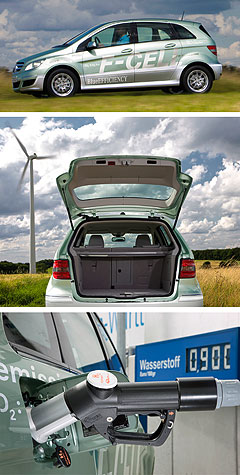Mercedes fuel-cell B-class to hit US, Euro markets
BY TERRY MARTIN | 31st Aug 2009

The German manufacturer claims the hydrogen-electric hybrid offers similar performance to a conventional 2.0-litre petrol-engine car and consumes the equivalent of 3.3 litres of diesel per 100km (combined), based on the NEDC European standard.
According to Mercedes, the B-class F-Cell features a new generation of its compact, high-performance fuel cell system, in which gaseous hydrogen reacts with atmospheric oxygen at 700 bar to generate a current for the electric motor.
In this case, the electric motor has peak power of 100kW and torque of 290Nm, which is available from the first rotation. The manufacturer claims the vehicle has a 385km range and a 170km/h maximum speed, and requires no more than about three minutes to refuel.

“(This) is the year in which we are establishing further milestones where sustainable mobility is concerned,” said Mercedes-Benz Cars group R&D chief Thomas Weber. “The B-class F-Cell is taking on a pioneering role as the world’s first fuel-cell-powered automobile to be produced under series production conditions.” The compact car’s fuel cell system is described as “completely new” compared with the drivetrain in the A-class F-Cell presented in 2004, with Mercedes-Benz engineers achieving “considerable improvements” in areas such as output, operating range, reliability, starting characteristics and comfort.
As GoAuto reported 12 months ago when first details of the improved system were released, the upgrade to hydrogen storage tanks using 700 bar pressure – up from 350 bar – extended the operating range of the A- and B-class-based development vehicles by up to 70 per cent.
The company now claims to have reached the point where “driving pleasure and day-to-day suitability” are now at “Mercedes level” for the emissions-free model. Dynamic handling properties are said to be “in some cases far better than those of a 2.0-litre petrol car”, while cold-start capability is “very good” at temperatures as low as minus-25 degrees Celsius.
The A- and B-class platform architecture has enabled Mercedes to locate the drive components within the so-called ‘sandwich floor’, where there is sufficient protection and minimum intrusion into the cabin or luggage compartment. As a result, the interior remains “fully usable” and maximum boot volume is rated at 416 litres.
Mercedes claims operational reliability of the F-Cell is of the same high level as its vehicles with conventional combustion engines, no matter what the conditions, and that its engineers have conducted more than 30 additional crash tests to optimise the safety of drive-specific components.
Apart from the strong branding shown on the launch vehicle, there are few distinguishing marks on the F-Cell to separate it from a standard B-class. Items of note include exclusive 10-spoke light-alloy wheels and a ‘bonamite’ silver paint finish. The cabin has premium appointments, including leather trim, headed seats and automatic climate-control air-conditioning.
“With more than 100 test vehicles and a combined total of over 4.5 million kilometres of trial testing, Daimler and Mercedes-Benz have the most extensive experience with fuel cell vehicles of any manufacturer worldwide,” the company said in a statement.
“The B class F-Cell is further testimony of this technology’s high level of development for automotive use. However, a comprehensive network of hydrogen filling stations still has to be set up before locally zero-emission driving can become a widespread reality.” To make this possible, Daimler said it was co-operating with government authorities, energy utilities and oil companies in joint projects in places such as Hamburg, Stuttgart and California.